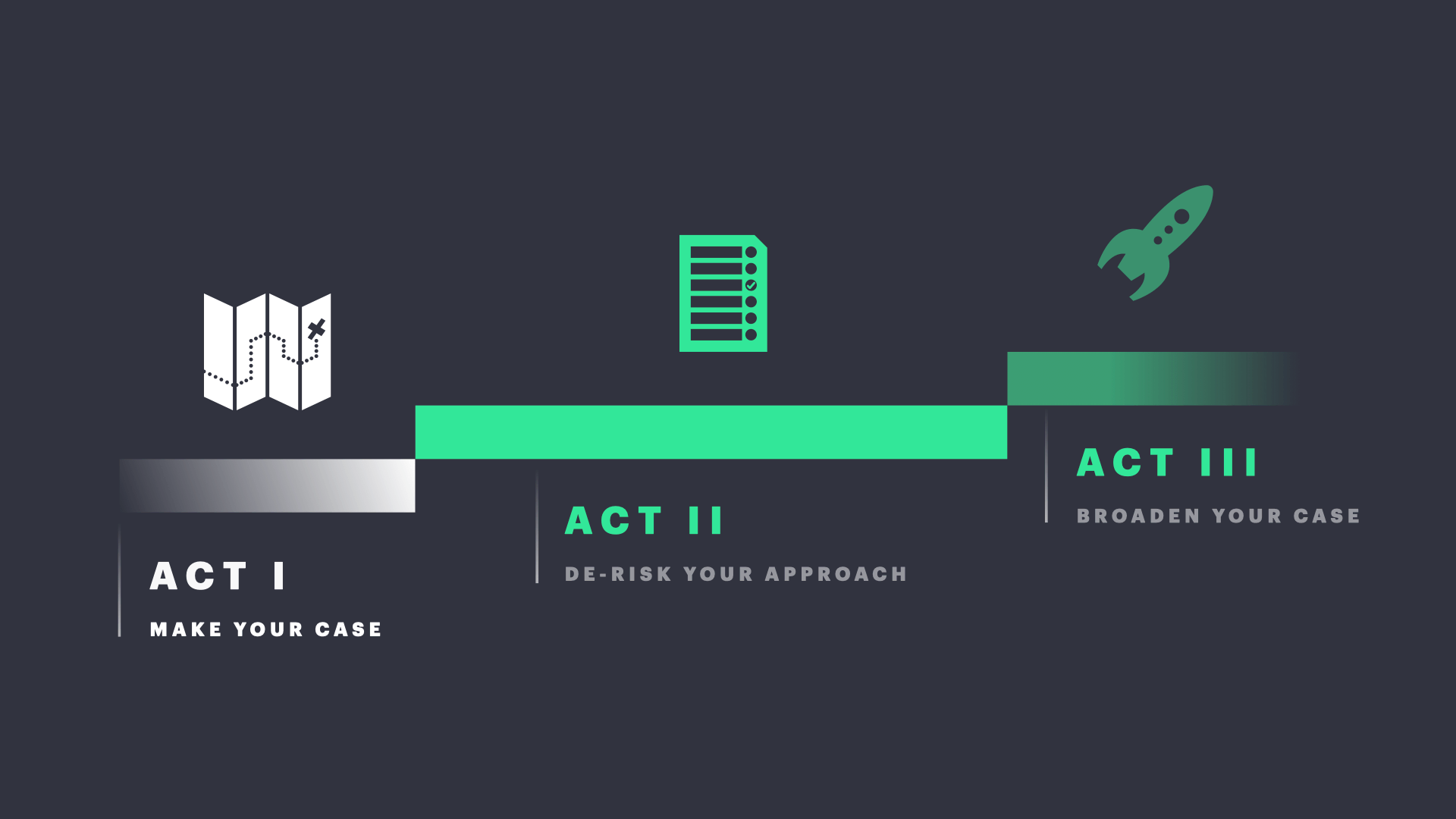Nadie crea una empresa porque le encanta recaudar fondos, pero para muchas empresas, acelerar una empresa para hacerla crecer requiere capital por millones o miles de millones de dólares.
Lamentablemente, la creación de presentaciones para recaudar fondos y la creación de propuestas para inversores no son habilidades que los fundadores desarrollen antes de crear una empresa; se aprenden haciendo. Por lo tanto, los emprendedores primerizos, a menudo, tienen dificultades para elaborar una historia, su historia, que terminará en una hoja de términos.
Si bien es cierto que cada empresa es única, también lo es que cada propuesta tiene el mismo objetivo: garantizarles a los inversores arriesgados que tu empresa tiene el potencial de lograr una valoración superior a los mil millones de dólares. Es posible que tu startup aún no genere ingresos, pero debe generar convicción.
Esta no es una hazaña menor. Requiere un salto tanto de razón como de fe, lo que significa que una propuesta eficaz debe infundir confianza e inspirar creencia. Un inversor necesita ver que eres un experto en tu espacio, un maestro de tus propios datos y el tipo de narrador que puede convencer a los clientes, empleados y a la próxima ronda de inversores de que se unan a ti en un viaje improbable. Fundador en etapa inicial, esto es para ti. Se basa en seis años de desarrollo de propuestas que han generado $4500 millones en capital recaudado. A medida que te embarcas en levantar tu semilla o ronda de Serie A, tendrás que contar una historia con una combinación de visión y ejecución adecuada a la etapa de tu empresa. Este recurso te ayudará a articular por qué debería existir tu empresa y a darles a los inversores la mejor oportunidad de entrecerrar los ojos y ver ese resultado de miles de millones de dólares. Comencemos.

Piensa en actos, no en diapositivas
El mundo de las startups tiene mucha tradición (y archivos profundos) sobre las propuestas. Hay comentarios sobre las primeras presentaciones de empresas ahora famosas, publicaciones que coinciden con patrones sobre la propuesta de inversores de capital de riesgo y plantillas de presentación en todo el mundo.
En lugar de pensar en diapositivas, te recomendamos que separes tu propuesta en tres “actos” básicos y trabajes a través de cada uno de ellos, uno por uno. Estos tres actos representan los movimientos esenciales de cada propuesta y les dan a los fundadores una idea clara de lo que se debe probar en cada etapa y cómo probarlo.
Los tres actos son los siguientes:
- Acto I: presentar tu caso. ¿Qué estás creando? ¿En qué puede convertirse? ¿Por qué ahora? ¿Por qué tú?
- Acto II: reducir el riesgo de tu enfoque. ¿Qué has hecho para aumentar tus probabilidades de éxito?
- Acto III: ampliar tu caso. ¿Qué significa el éxito para ti, tus inversores y el mundo?

En esta guía, nos centraremos en el primer acto. Aquí es donde los fundadores establecen el tono de la propuesta y el marco para todo lo que sigue, mientras que el segundo y tercer acto se apoyan en puntos de prueba específicos de la empresa. El primer acto es donde dedicamos la mayor parte de nuestro tiempo a los fundadores: descubrimos que dedicamos más de la mitad de nuestro tiempo a elaborar y perfeccionar las primeras diapositivas de la propuesta. Es muy importante.
El primer acto y las tramas de tu propuesta
El primer acto de tu propuesta, o las primeras diapositivas, deben atraer a un inversor. Hay una idea errónea de que debes seguir una secuencia estricta de diapositivas para presentar un caso convincente. De hecho, el primer acto de una propuesta puede contener cualquier combinación de diapositivas, siempre y cuando comunique lo siguiente:
- Comprensión única de tu mercado
- Información clave sobre ese mercado
- Producto o servicio único
- Señal de que tu enfoque está funcionando
Se debe causar mucha impresión y se debe transmitir mucha información a través de las diapositivas de apertura, por no hablar de una presentación completa. El primer acto hace el trabajo pesado, y debe hacerlo de manera eficiente. A lo largo de los años, hemos notado algunas narrativas recurrentes al producir primeros actos fuertes. A estas las llamamos “tramas” de propuesta o marcos para organizar tu historia. Elegir la trama de propuesta correcta es un primer paso crítico.
Las cinco tramas de propuesta más comunes
La mayoría de las startups en etapa inicial se incluyen en una de las cinco tramas de propuesta. Cada una tiene una estructura similar:
- Los compases son las partes de una historia que se basan unas en otras para formar una trama. Una buena regla general es asignar una diapositiva, y un minuto o menos de hablar, por compás.
- El modelo de presentación en cada sección ilustra cómo conectar los compases y cómo podría verse cada trama de la propuesta en la vida real.
- Las notas de campo son nuestras principales observaciones sobre cada trama de propuesta, a saber, dónde han funcionado mejor y dónde se quedaron cortas para los fundadores y las empresas.
Una última e importante nota: no hay una trama que funcione mejor, todas han trabajado con inversores. Antes de presentarla, experimenta con diferentes tramas de propuesta para encontrar la que te permita explicar de forma auténtica el mejor y más resonante caso para tu oportunidad.
🔄 Empezar de nuevo
A muchos inversores les gusta hacer apuestas audaces: pocas apuestas son más osadas que reinventar un mercado desde cero. Piensa en Tesla o Ethos o, quizás, en el economista Joseph Schumpeter, ya que esta trama desata el “vendaval de destrucción creativa” a través del cual evoluciona un sector al nivelarse y recrearse.
Los compases
“Este es el desastre que es nuestro mercado hoy...”
La idea aquí es pintar una imagen de un mercado, un sector o un flujo de trabajo que está estancado en el pasado. Tal vez aún esté sumido en papeleo. Puede implicar horas de trabajo manual que podría completarse en segundos con automatización. Tal vez el software no haya mejorado desde 1980. O simplemente no haya despegado. Tu objetivo es hacer que la audiencia sienta este gran nivel de inercia, ya sea con estadísticas, imágenes o una anécdota poderosa.
“Así es como llegó allí...”
Capacita a tu audiencia. Ayúdala a comprender por qué el mercado se ve de la manera en que lo hace. ¿Está dominado por operadores tradicionales sin incentivos (o capacidad) para innovar? ¿Hay alguna razón histórica por la que tuvo que ser de la manera que es, pero ya no lo es? ¿Ha habido un gran desafío tecnológico que aún no se ha resuelto? Sea cual sea la respuesta, debe preparar perfectamente el escenario para la información clave que estás a punto de dar a conocer.
“¿Y si pudiéramos empezar de cero?”
Haz borrón y cuenta nueva y demuestra cómo tu empresa tiene una clara ventaja precisamente porque eres un nuevo participante. Muéstrale al inversor cómo podría reconstruirse este mercado si un fundador no tuviera el bagaje de ser un titular, la carga de la historia o la falta de tecnología disponible. Haz que la solución parezca simple, sencilla e inevitable.
"Eso es lo que hemos hecho..."
Contrasta tu solución con el desastre que describiste anteriormente. Acompaña a tu audiencia a través de cómo funciona tu producto, centrándote en las diferencias tangibles que resultan de comenzar desde cero: ¿es más rápido, barato, encantador, menos oneroso o simplemente mejor que lo que hay?
El modelo de presentación

Las notas de campo
Cuándo funciona. Esta trama funciona mejor si estás capacitando a los inversores en un mercado que les es desconocido. Te permite demostrar experiencia y les da a tus inversores la libertad de evaluar tu empresa en el vacío. Si puedes convencer a un inversor de que tu empresa es la única que adopta tu enfoque, entonces eres el único fundador que importa.
Ten cuidado. Evita “capacitar” a un inversor con una historia que ya conozca. Si no sabes lo que definitivamente sabe un observador interesado en tu campo, no conoces tu campo. Y peor aún, es una señal negativa. Por ejemplo, no articules tu propuesta ante inversores fintech sobre los desafíos de los no bancarizados. Es casi seguro que hayan escuchado (y probablemente hayan financiado) esa propuesta. Lo último que quieres es quedar atrapado en un debate de diez minutos en la primera diapositiva, o peor aún, generar guiños intencionados y miradas en blanco. También es importante considerar qué tiene tu enfoque que lo hace único. Por ejemplo, si lo que te diferencia es tu estrategia de marketing, en lugar de algo más defendible, podría ser difícil argumentar que estás reimaginando fundamentalmente tu mercado, y tu propuesta podría parecer una exageración.
⬇️ Hacer eso aquí
Una analogía precisa y potente es muy útil, especialmente cuando tus análogos se valoran en el rango de más de $1000 millones. Las versiones en etapa inicial de Catch («Gusto para trabajadores independientes») o BallerTV (“ESPN para deportes de aficionados”) habrían sido buenos candidatos para esta trama. Esta es una opción particularmente útil cuando tus inversores aún no están íntimamente familiarizados con tu mercado.
Los compases
“Mira este otro mercado (o estos otros mercados) que han evolucionado...”
Las grandes olas mueven todos los barcos, por lo que, si ves que otros mercados importantes se transforman por una tendencia, es probable que esa tendencia llegue a tu mercado pronto. En el pasado, estas fuerzas pudieron haber sido la movilidad, la nube o el Internet de las cosas. Hoy en día, es más probable que sean inteligencia artificial, decisiones en tiempo real o cualquier cantidad de tendencias que estén remodelando los mercados. Estos ejemplos son poderosos porque preparan tu enfoque antes de que lo introduzcas.
“Nuestro mercado se ha quedado atrás...”
A continuación, establece un fuerte contraste entre estos mercados y los tuyos explicando cómo funciona tu mercado hoy. Enfócate en los puntos débiles creados por estas fuerzas que no se reflejan. Si se hace bien, crearás una sensación de inevitabilidad. La naturaleza aborrece el vacío.
“Se vería así...”
Esta es tu oportunidad de pagar la analogía. Pinta un cuadro de cómo sería tu mercado si cumpliera con el estándar moderno. Lleva a tu audiencia paso a paso a través de una experiencia transformada y sus implicaciones para los usuarios, para tu sector y para la empresa que puede ofrecer esa experiencia.
“Esto es exactamente lo que estamos creando...”
Presenta a tu empresa como el agente de cambio entre donde se encuentra el mercado hoy y el mundo perfecto que acabas de exponer. Explica lo que ya has logrado para ponerte en ese camino y lo que queda por hacer. La idea es demostrar, de forma sencilla y clara, que estás en camino de hacer realidad esa visión.
El modelo de presentación

Las notas de campo
Cuándo funciona. Esta trama depende completamente del tamaño de la brecha entre dónde está tu mercado y qué debería, sería o podría ser con la tecnología adecuada. También es particularmente eficaz si puedes destilar lo que te hace único hasta un solo modelo de tecnología o modelo de negocio (p. ej., inteligencia artificial, SaaS, etc.) para que el enlace a otros mercados sea bien claro.
Ten cuidado. Prueba la presión de cada aspecto de la analogía para asegurarte de que sea hermética. Si hay alguna inconsistencia entre tu mercado y su analógico, los inversores comenzarán a hacer agujeros. Cuantas menos variables haya entre los dos mercados, mejor. Lo último que quieres hacer es dejarte arrastrar por una discusión sobre un mercado en el que ni siquiera operas. Además, hay una buena posibilidad de que los inversores hayan dedicado tiempo (y capital) a ser inteligentes en tus mercados analógicos.
💡 Pero esta es la cuestión...
No se trata de una trama retórica, pero puede ser una forma increíblemente eficaz de abrir una propuesta. Si tu objetivo es convencer a un inversor de que eres la mejor persona para resolver un problema, lo mejor que puedes hacer es demostrar que entiendes el problema mejor que nadie. Por ejemplo, esta trama podría ser una buena opción para Rahul Vohra, del servicio de correo electrónico Superhuman. Ha pasado más de una década reinventando el correo electrónico como fundador (Rapportive, Superhuman), inversor (sendwithus) y asesor (InboxVudu).
Los compases
“Los expertos en nuestro mercado saben que...”
Comienza con un dato o estadística interesante que un inversor aún no conoce y que probablemente no encontraría en su investigación superficial antes de tu reunión. Lo ideal es que esta estadística sea inesperada, contradictoria o simplemente interesante. Pero, lo más importante es que debe configurar el siguiente compás de tu historia.
“Pero esta es la cuestión...”
Introduce tu información única aquí. Si es una observación que conocen los expertos, entonces tu información debe ofrecer una perspectiva que sea exclusivamente tuya. La idea es ir un nivel más allá de tu dato inicial o estadística para revelar una verdad oculta sobre tu mercado. Por ejemplo, si tu dato interesante es que tu mercado está creciendo increíblemente rápido, entonces tu información podría ser que el mercado sigue siendo significativamente más pequeño de lo que debería ser.
“Esto abre la puerta a una oportunidad masiva...”
Conecta tu visión única con la oportunidad de negocio que tienes enfrente. La consecuencia es que, con tu visión única, puedes crear un tipo específico de empresa que no se parece a ninguna otra cosa en el mercado. Por ejemplo, si tu mercado está muy poco penetrado, puedes centrarte en el hecho de que estás creando un producto que no competirá de inmediato con los operadores tradicionales porque sirve a un mercado oculto que es adyacente al mercado actual.
“Estamos hechos para esto...”
Presenta tu empresa en este contexto. Explica con claridad cómo se ha diseñado todo lo relacionado con tu empresa, desde el producto hasta la salida al mercado, para explotar esta información única.
El modelo de presentación

Las notas de campo
Cuándo funciona. Esta es una trama desafiante basada en la extracción porque requiere que presentes (1) un hecho o estadística que tu audiencia aún no conoce y (2) una visión que se sienta fresca y original. Como resultado, esta táctica funciona mejor cuando tienes una ventaja significativa de información sobre el inversor, lo que significa que los fundadores que han trabajado en el sector y establecen credibilidad a menudo tienen el mayor éxito.
Ten cuidado. Si tu “hecho interesante” o tu “conocimiento único” ya son familiares para tu audiencia (o si son intuitivos para la mayoría de las personas), esta apertura se desmoronará y tu rigor o credibilidad pueden estar en duda. Una vez que te hayas asentado en las estadísticas y conocimientos que planeas compartir, primero valida que sean realmente únicos. Dirígelos por colegas, expertos del sector e inversores amistosos. Si no los estás impresionando con tu originalidad, es probable que tampoco impresiones a los inversores.
📱 Todos los niños lo están haciendo
Uno de los mayores desafíos en cualquier propuesta es demostrar diferenciación. Para hacerlo, debes mostrar cómo tu oferta está generando innegablemente un nuevo comportamiento de cliente o beneficiándose de él de manera única. Esta trama podría ser la primera opción para un GitHub o Figma en etapa inicial.
Los compases
“Hay un gran cambio de comportamiento en marcha...”
Esta trama comienza con una tendencia subyacente que sienta las bases de tu empresa, pero no las tendencias que ves en todas las demás propuestas. Debes dar la sensación de que has descubierto una tendencia, no solo leído sobre ella. Así que evita los estudios de Gartner y las encuestas a los consumidores, y busca datos o anécdotas que revelen una tendencia que está oculta a plena vista. Imagina Airbnb en sus primeros días apuntando a la aparición de listados temporales de viviendas en sitios como Craigslist como evidencia de que la gente estaba interesada en alojamientos no hoteleros.
“Los titulares no están listos para ello...”
Si has demostrado efectivamente que una tendencia es real, entonces tu siguiente tarea es demostrar que los operadores tradicionales no la ven o no pueden moverse lo suficientemente rápido como para responder a ella. Ilustra el choque entre las expectativas del usuario y lo que ofrecen los operadores tradicionales.
“Lo vimos venir...”
Aprovecha tu historia de origen para ilustrar adecuación del fundador al mercado. Demuestra que estás en la cúspide de la oportunidad para la cual te has preparado durante años, no por un accidente, sino porque lo has estado planeando. Muestra cómo se creó tu empresa con un profundo conocimiento de esta tendencia, y cómo esto se ha traducido en tu enfoque para el desarrollo de productos, ve al mercado, a la creación de equipos y más.
“Creamos una empresa para este nuevo mundo...”
Proporciona evidencia temprana de que te estás beneficiando de esta tendencia. Esto podría ser tracción temprana, testimonios de clientes o cualquier otro indicio de que estás resonando con los primeros usuarios. Da a los inversores la sensación de que has descubierto lo inevitable.
El modelo de presentación

Las notas de campo
Cuándo funciona. Si tu empresa está a la vanguardia de una tendencia emergente que otros aún no están viendo, esta puede ser una trama poderosa. El ejemplo de Airbnb es instructivo. Lo ideal es que la tendencia que estás identificando solo se encuentre si miras profundamente dentro de los datos. Debe ser algo que solo tú estabas buscando y encontraste. Es probable que la información que marca la época no esté disponible a través de una búsqueda en Google; demuestra que has obtenido el conocimiento.
Ten cuidado. Los inversores buscan tendencias a largo plazo que transformen los mercados, no repuntes temporales. En los últimos meses, hemos visto propuesta tras propuesta aprovechar la COVID-19 como el punto de inflexión para su mercado o su producto. Pero ¿es probable que el cambio que estás viendo dure más que la pandemia? Y, de ser así, ¿cómo puedes dejarlo claro a un inversor?
✋ Lo tomé como algo personal
Los inversores buscan fundadores que dediquen sus vidas a resolver un problema, lo que significa que es increíblemente poderoso si hablas de cómo ese problema te ha afectado en lo personal. Por ejemplo, esta trama podría haber sido utilizada por John Crowley. Cuando a dos de sus hijos se les diagnosticó la enfermedad de Pompe, Crowley dejó una carrera en finanzas para desarrollar tratamientos para personas con enfermedades raras y pocas opciones. Impulsado a ayudar a sus hijos, ha pasado décadas trabajando y fundando empresas biotecnológicas y farmacéuticas. Ahora lidera Amicus Therapeutics, que descubre, fabrica y entrega medicamentos para personas que viven con enfermedades metabólicas raras.
Los compases
“Déjame contarte sobre un momento en que intenté...”
Comparte tu historia personal de lucha. Esta puede ser una historia de “peces fuera del agua” en la que tú, como extraño, intentaste algo por primera vez (p. ej., solicitar una hipoteca). O puede ser una historia de “béisbol interno” en la que luchaste con un problema que ha asolado durante mucho tiempo a los miembros de tu comunidad de práctica (p. ej., revisar manualmente las solicitudes de hipoteca).
“Fue una experiencia horrible...”
Resume la historia sintetizando las dos o tres barreras fundamentales que se interpusieron en el camino para que este proceso fuera lo más fluido, intuitivo, simple o eficaz que pudiera ser. Aquí es donde configuras los problemas que tenías que creer que podrías resolver antes de iniciar tu empresa.
“Investigué...”
Recorre los pasos que diste para comprender mejor este problema. ¿Con quién conversaste? ¿Qué aprendiste sobre el tamaño y el alcance de este problema? ¿Cuánto tiempo dedicaste a iterar en tu idea? ¿A quiénes pudiste reclutar para que te ayuden a asumir este desafío? Estas son las historias que resuenan con los inversores y les dan la confianza de que estás comprometido a resolver el problema que tienes enfrente.
“Construí la solución que me gustaría...”
Ilustra cómo tu producto resuelve el problema al que te enfrentabas. Pero haz la transición rápidamente al valor que tu producto puede aportar al mercado en general. Esta es tu oportunidad de demostrar que, al resolver un problema por ti mismo, destapaste una oportunidad de empresa masiva.
El modelo de presentación

Las notas de campo
Cuándo funciona. Solo recomendamos esta trama a los fundadores con una historia auténtica que contar. Los inversores se aburren hasta las lágrimas porque los fundadores se fuerzan a sí mismos a convertirse en el héroe de la historia. Pero si tu historia de origen es fundamental para la narrativa que compartes con los clientes o empleados, es una buena indicación de que también resonará con los inversores.
Ten cuidado. Incluso si tu historia es auténtica, solo funciona si es relatable. No es necesario que los inversores hayan experimentado el problema ellos mismos, pero deberían poder ponerse en tu lugar. Si un problema es complejo o esotérico, o se siente como un “agradable tener” frente a un “imprescindible”, una historia personal no solo puede perder su impulso, sino también su moneda.
Las tramas se complican
Una vez que hayas elegido tu trama de propuesta, has dado un paso importante en la definición de tu presentación para recaudar fondos. Mantén el rumbo y crea el segundo y tercer acto de tu propuesta. Si necesitas ayuda, mira la grabación de nuestra AMA, donde profundizamos en las propuestas para recaudar fondos. Obtén más información sobre 4th & King y escríbenos a: hello@4thandking.com.
Stripe Atlas tiene recursos adicionales para ayudarte con tu recaudación de fondos. Lee más sobre cómo presentar tu startup en etapa inicial. Para mantenerte al día sobre guías similares para startups o si tienes alguna idea sobre qué otras guías serían útiles para tu empresa en línea, escríbenos a: atlas@stripe.com.

